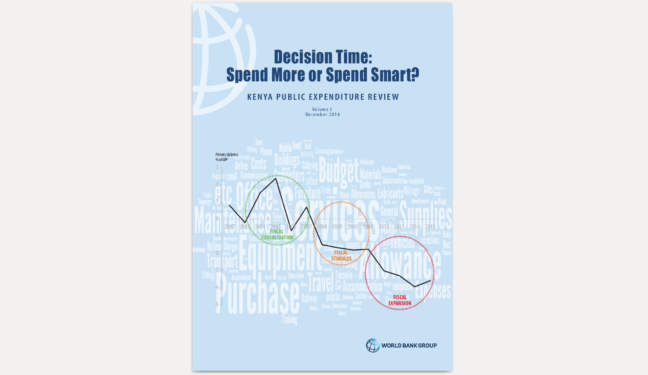

Decision Time: Spend More or Spend Smart?- Kenya Public Expenditure Review, December 2014.
This Public Expenditure Review (PER) 2014 highlights tremendous progress that Kenya has made in three areas: First, the economy has grown by six percent since 2010; a major
recovery from negative shocks experienced in previous years. And following the rebasing
of GDP, Kenya has now joined the league of Lower Middle Income Countries. Second,
the country is just under two years into rolling out an ambitious devolution process that has significantly transformed the way that public finances are administered. Transfers to county governments now constitute about 20 percent of total expenditure, or about 4 percent of GDP. Third, investments in infrastructure have grown considerably—now second only to education—projected to increase to half the capital budget by 2017. Kenya is certainly moving in the right direction in terms of building up its infrastructure to enhance its growth potential.
Nevertheless, numerous challenges continue to impact on the economy. The effects of
increasing public debt and mounting public expenditure are beginning to be felt. The pressure to spend more that started building before the roll out of devolution is likely to prevail for a few more years. The reasons are varied and weighty: rising costs of rolling out devolution; costs of financing national security; huge infrastructure investments; funding of flagship projects to fulfill pre-election pledges; and, a hefty public wage bill, among others.
This PER examines the opportunities and constraints facing the government in public
expenditure management, especially on how resources are allocated and utilized.
The PER emphasizes that the time is now for Kenya to reflect on the big decisions going
forward: spending more or spending smart? In this regard, it will be important to contain the growth of administrative recurrent costs, improve execution of infrastructure projects, and provide sufficiently for recurrent operating costs.
It is our hope that this report will make a useful contribution towards the ways in which the Government of Kenya and its partners, including the World Bank, design and implement policies and programs. In so doing, we hope to continue to maximize the unique opportunities now available to Kenya through better allocating and utilizing its financial resources, with the ultimate aim of achieving the country’s ambitious development goals.
